1996 CHEVROLET S10 maintenance
[x] Cancel search: maintenancePage 257 of 375
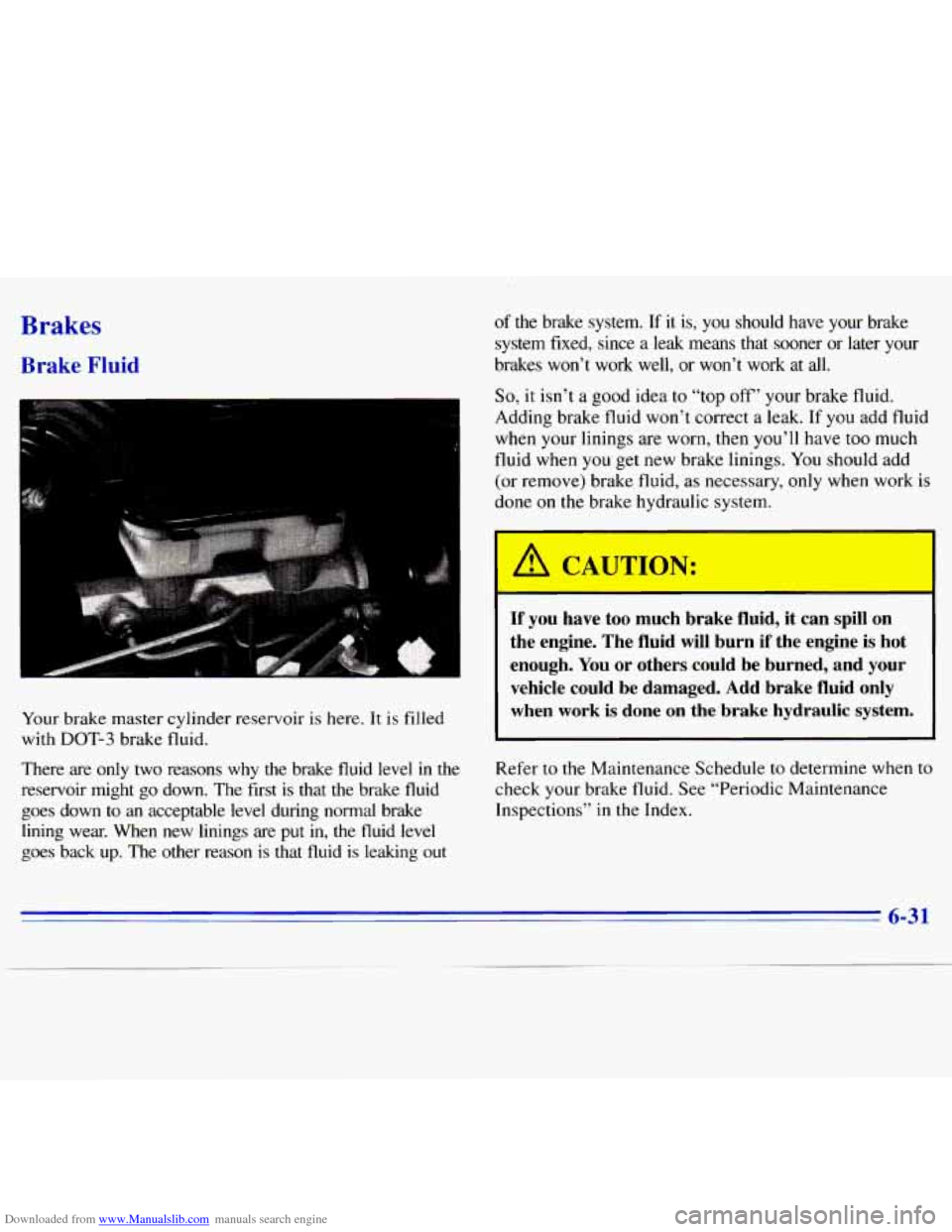
Downloaded from www.Manualslib.com manuals search engine Brakes
Brake Fluid
Your brake master cylinder reservoir is here. It is filled
with
DOT-3 brake fluid.
There are only two reasons
why the brake fluid level in the
reservoir might
go down. The first is that the brake fluid
goes down
to an acceptable level during normal brake
lining wear. When new linings
are put in, the fluid level
goes back up. The other reason
is that fluid is leaking out
of the brake system. If it is, you should have your brake
system fixed, since a leak means that sooner or later your
brakes won’t work well, or won’t work at all.
So, it isn’t a good idea to “top off’ your brake fluid.
Adding brake fluid won’t correct a leak.
If you add fluid
when your linings are worn,
then you’ll have too much
fluid when
you get new brake linings. You should add
(or remove) brake fluid, as necessary, only when work
is
done on the brake hydraulic system.
’ A CAUTION: I
If you have too much brake fluid, it can spill on
the engine. The fluid will burn if the engine is hot
enough. You or others could be burned, and your
vehicle could be damaged. Add brake fluid only
when work
is done on the brake hydraulic system.
Refer to the Maintenance Schedule to determine when to
check your brake fluid. See “Periodic Maintenance
Inspections”
in the Index.
6-31
Page 268 of 375
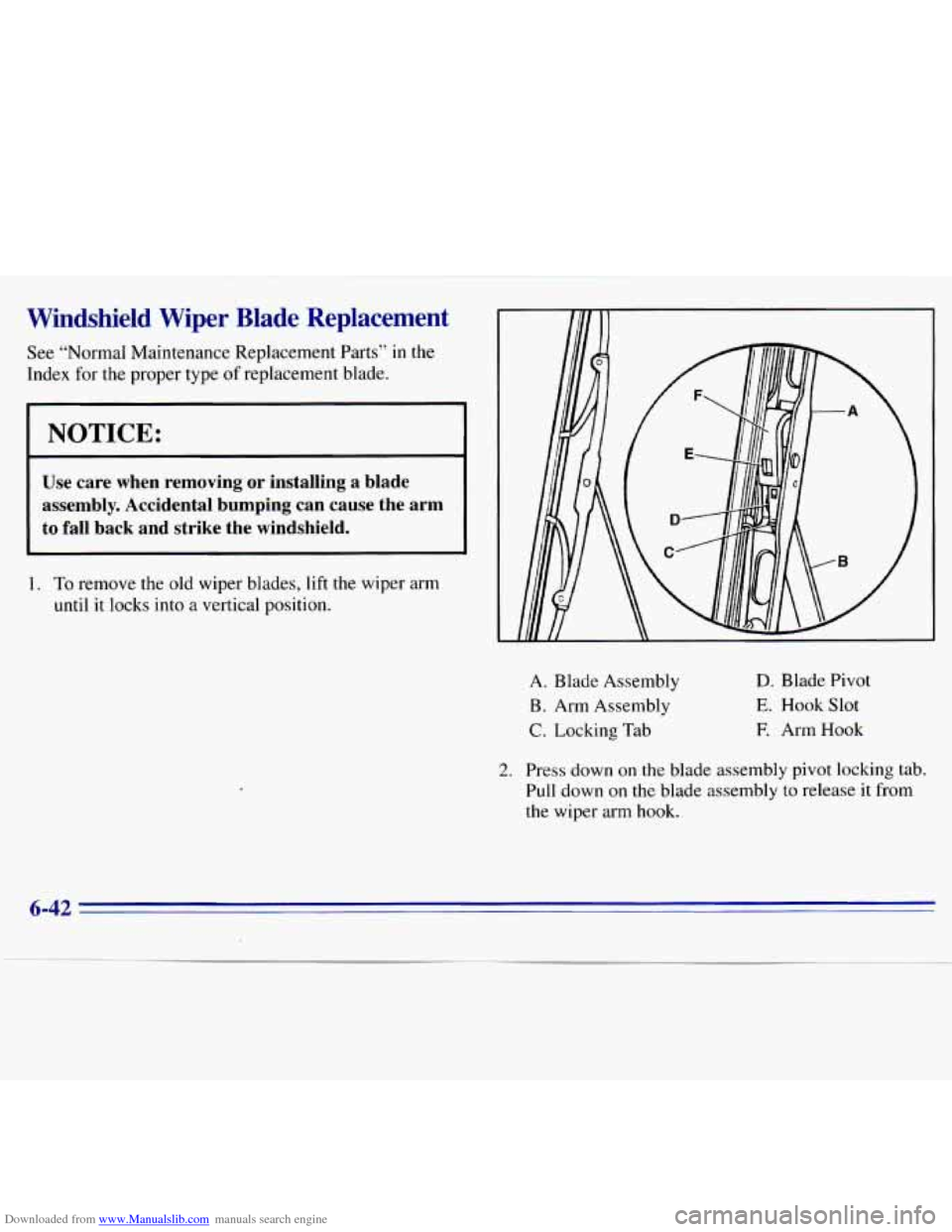
Downloaded from www.Manualslib.com manuals search engine Windshield Wiper Blade Replacement
See “Normal Maintenance Replacement Parts” in the
Index for the proper type
of replacement blade.
NOTICE:
Use care when removing or installing a blade
assembly. Accidental bumping can cause the arm
to fall back and strike the windshield.
1. To remove the old wiper blades, lift the wiper arm
until it locks into a vertical position.
A. Blade Assembly
B. Arm Assembly
C. Locking Tab
D. Blade Pivot
E. Hook Slot
E Arm Hook
2. Press down on the blade assembly pivot locking tab.
Pull down on
the blade assembly to release it from
the wiper arm hook.
6-42
Page 272 of 375
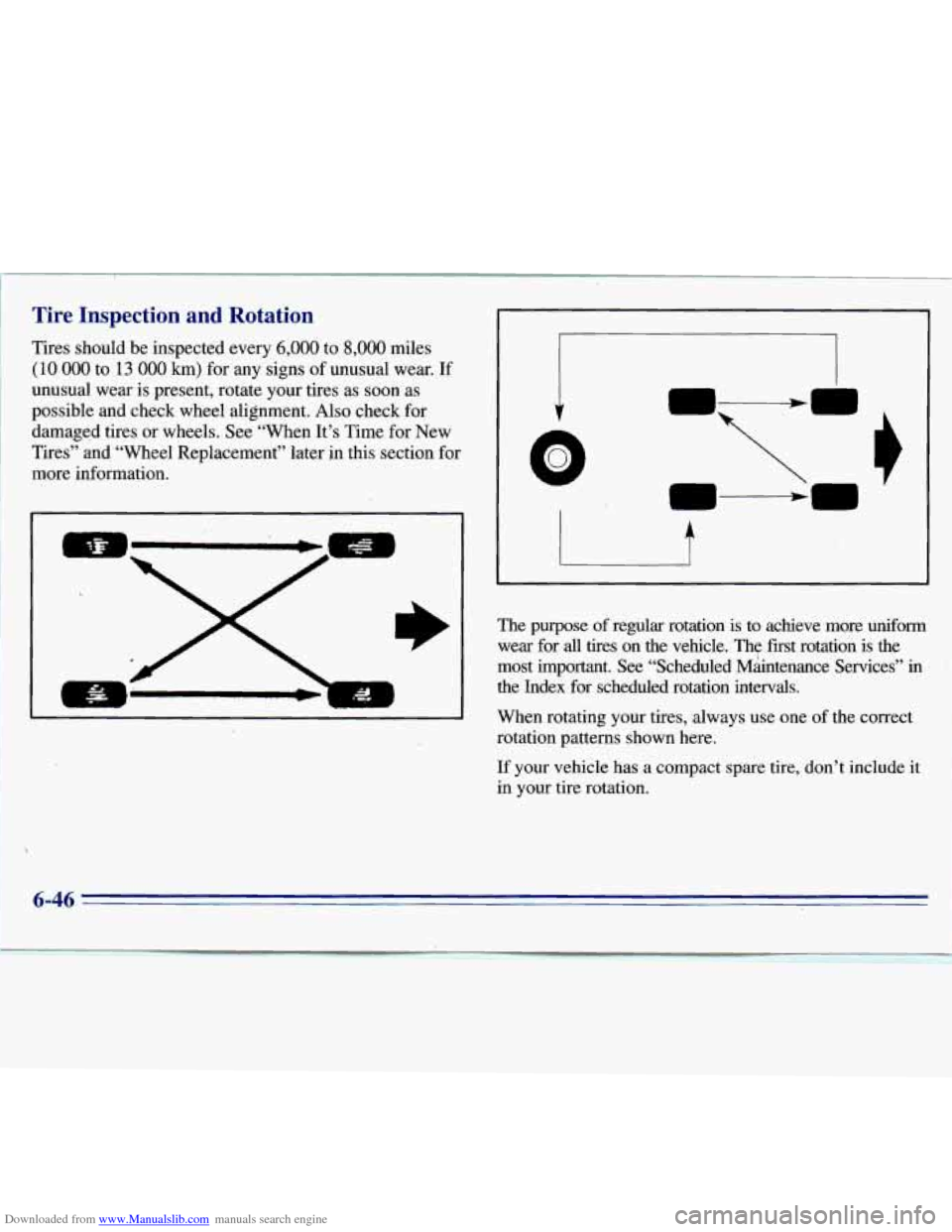
Downloaded from www.Manualslib.com manuals search engine Tire Inspection and Rotation
Fires should be inspected every 6,000 to 8,000 miles
(10 000 to 13 000 km) for any signs of unusual wear. If
unusual wear is present, rotate your tires as
soon as
possible and check wheel alignment. Also check for
damaged tires or wheels. See “When It’s Time for New
Tires” and“‘Whee1 Replacement” later
in this section for
more information.
I
J.
@
I
The purpose of regular rotation is to achieve more uniforrn
wear for all tires on the vehicle. Thy first rotation is the
most important.
See “Scheduled Maintenance Services” in
the Index for scheduled rotation intervals.
When rotating your tires, always use one
of the correct
rotation patterns shown here.
If your vehicle has a compact spare tire, don’t include it
in your tire rotation.
6-46
Page 285 of 375
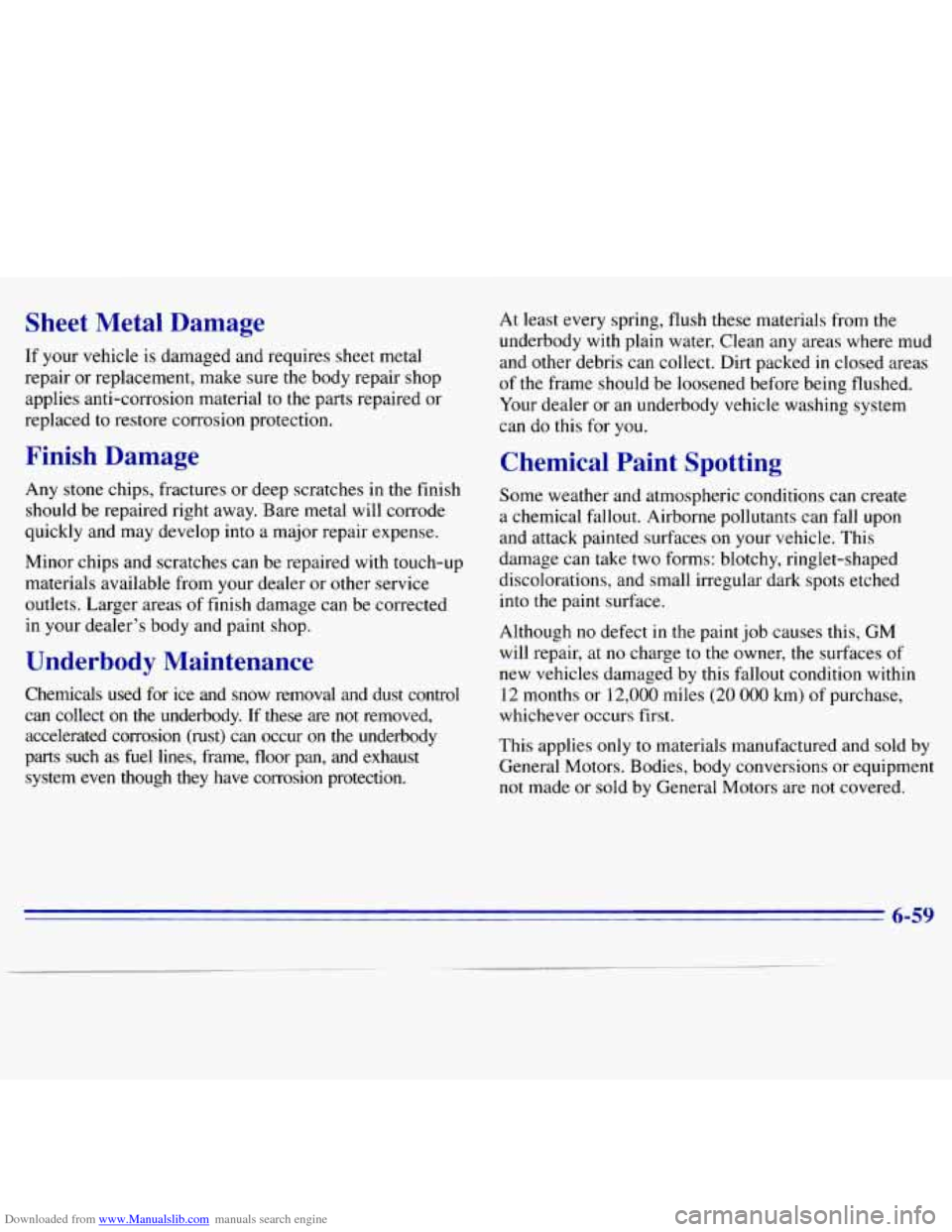
Downloaded from www.Manualslib.com manuals search engine Sheet Metal Damage
If your vehicle is damaged and requires sheet metal
repair or replacement, make sure the body repair shop
applies anti-corrosion material to the parts repaired or
replaced to restore corrosion protection.
Finish Damage
Any stone chips, fractures or deep scratches in the finish
should be repaired right away. Bare metal will corrode
quickly and may develop into a major repair expense.
Minor chips and scratches can be repaired with touch-up
materials available from your dealer or other service
outlets. Larger areas
of finish damage can be corrected
in your dealer’s body and paint shop.
Underbody Maintenance
Chemicals used for ice and snow removal and dust control
can collect
on the underbody. If these are not removed,
accelerated corrosion (rust) can occur
on the underbody
parts such as fuel lines, frame, floor pan, and exhaust
system even though they have corrosion protection. At least
every spring,
flush these materials from the
underbody with plain water. Clean any areas where mud
and other debris can collect. Dirt packed
in closed areas
of the frame should be loosened before being flushed.
Your dealer or an underbody vehicle washing system
can do this for you.
Chemical Paint Spotting
Some weather and atmospheric conditions can create
a chemical fallout. Airborne pollutants can fall upon
and attack painted surfaces on your vehicle. This
damage can take two forms: blotchy, ringlet-shaped
discolorations, and small irregular dark spots etched
into
the paint surface.
Although no defect in the paint job causes this, GM
will repair, at no charge to the owner, the surfaces of
new vehicles damaged by this fallout condition within
12 months or 12,000 miles (20 000 km) of purchase,
whichever occurs first.
This applies only
to materials manufactured and sold by
General Motors. Bodies, body conversions or equipment
not made or sold by General Motors are not covered.
Page 293 of 375

Downloaded from www.Manualslib.com manuals search engine Normal Maintenance Replacement Parts
Replacement part numbers listed in this section are based on the latest information available at the time of printing,
and are subject
to change. If a part listed in this manual is not the same as the part used in your vehicle when it was
built,
or if you have any questions, please contact your GM truck dealer.
Engine
Thermostat
Oil Filter
Air Cleaner Filter
PCV Valve Automatic Transmission Filter Kit
Spark Plugs
Fuel Filter
Windshield Wiper Blades
2.2L
10 182377
PF47
A1163C
cv9ooc 24200796
4 1-928
GF48 1
Trico (20 inched5
1 cm)
“VORTEC” 4300
1255 1472
PF52
A1 163C
CV746C 24200796
4 1-932
GF48 1
Trico
(20 inched5 1 cm)
6-67
Page 297 of 375
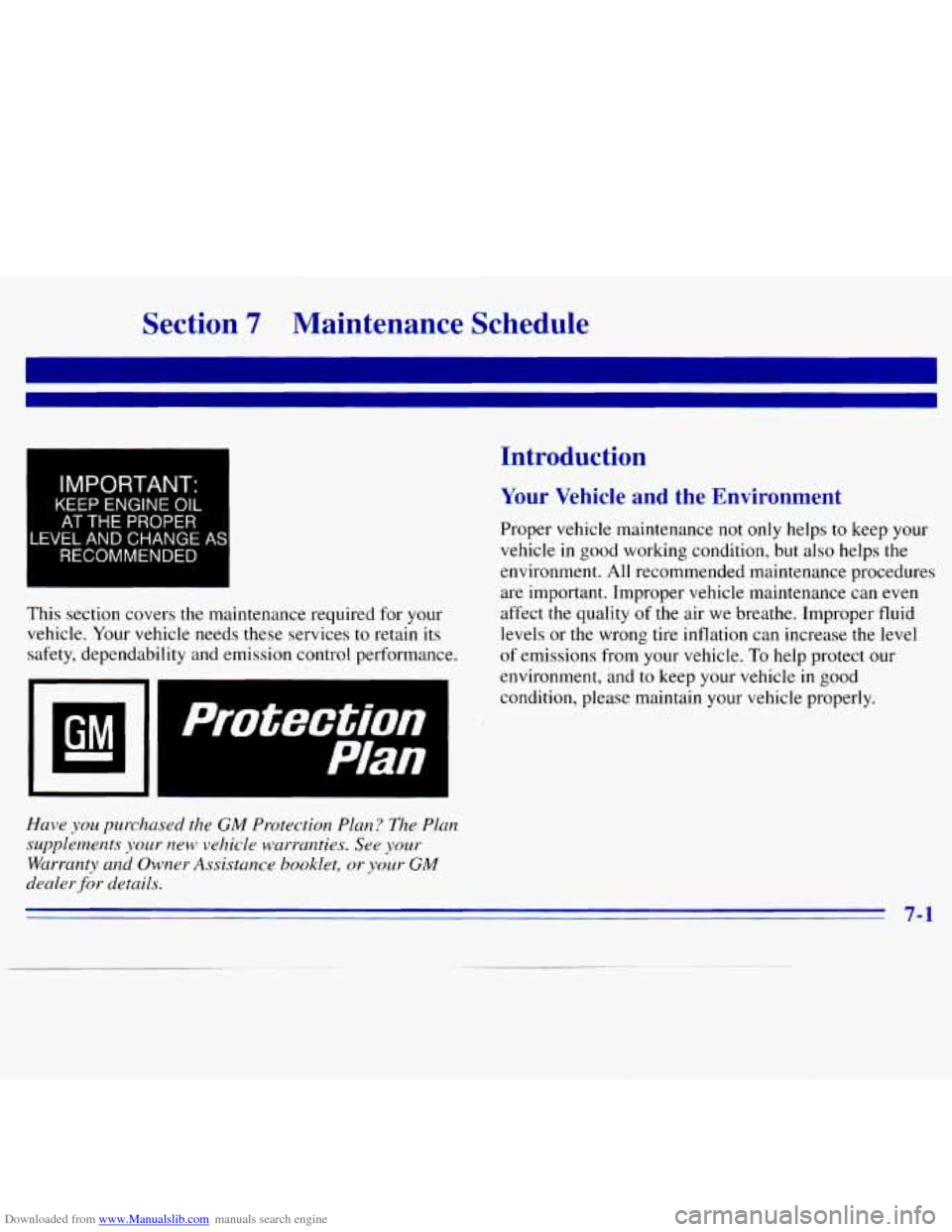
Downloaded from www.Manualslib.com manuals search engine Section 7 Maintenance Schedule
IMPORTANT.
KEEP ENGINE OIL
AT THE PROPER
LEVEL AND CHANGE A!
RECOMMENDED
This section covers the maintenance required for your
vehicle. Your vehicle needs these services to retain its
safety, dependability and emission control performance.
Protection
Plan
Have you purchased the GM Protection Plan? The Plan
supplements your new vehicle warranties. See your
Warrunty and Owner Assistance hooklet, or yo~u GM
dealer for details.
Introd, :tior
Your Ve .cle and the Environment
Proper vehicle maintenance not only helps to keep your
vehicle in good working condition, but also helps
the
environment. All recommended maintenance procedures
are important. Improper vehicle maintenance can even
affect
the quality of the air we breathe. Improper fluid
levels or the wrong tire inflation can increase the level
of emissions from your vehicle.
To help protect our
environment, and to keep your vehicle
in good
condition, please maintain your vehicle properly.
7-1
Page 298 of 375
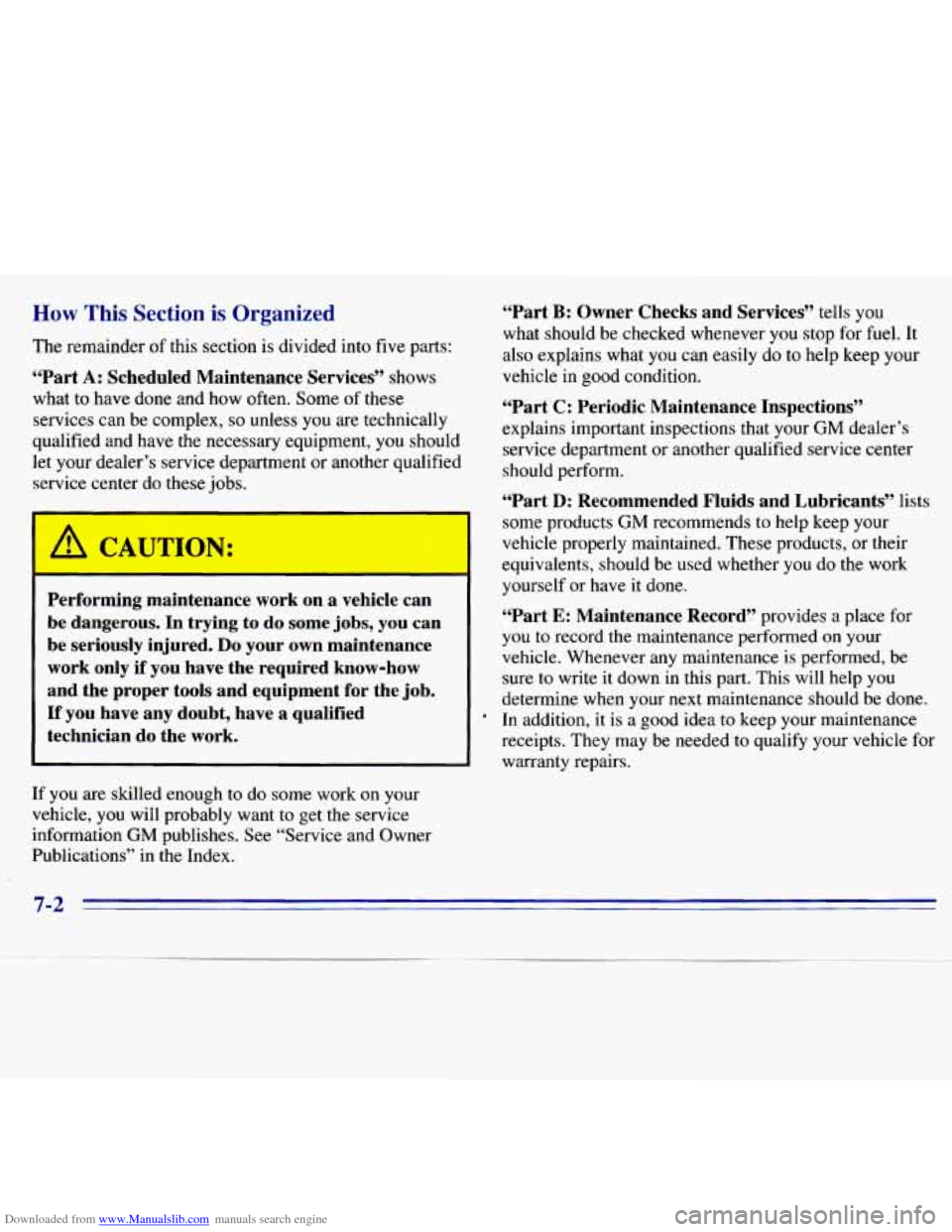
Downloaded from www.Manualslib.com manuals search engine How This Section is Organized
The remainder of this section is divided into five parts:
“Part
A: Scheduled Maintenance Services” shows
what to have done and how often. Some
of these
services can be complex,
so unless you are technically
qualified and have the necessary equipment, you should
let your dealer’s service department or another qualified
service center do these jobs.
Performing maintenance work on a vehicle can
be dangerous. In trying
to do some jobs, you can
be seriously injured.
Do your own maintenance
work only if you have the required know-how
and the proper tools and equipment for the job.
If you have any doubt, have a qualified
technician do the
work.
If you are skilled enough to do some work on your
vehicle, you will probably want to get the service
information
GM publishes. See “Service and Owner
Publications” in the Index.
.
“Part B: Owner Checks and Services” tells you
what should be checked whenever
you stop for fuel. It
also explains what you can easily
do to help keep your
vehicle
in good condition.
“Part C: Periodic Maintenance Inspections”
explains important inspections that your
GM dealer’s
service department or another qualified service center
should perform.
“Part
D: Recommended Fluids and Lubricants” lists
some products
GM recommends to help keep your
vehicle properly maintained. These products, or their
equivalents, should be used whether you do the work
yourself or have it done.
“Part
E: Maintenance Record’.‘ provides a place for
you to record the maintenance performed on your
vehicle. Whenever any maintenance is performed, be
sure
to write it down in this part. This will help you
determine when your next maintenance should be done.
In addition, it
is a good idea to keep your maintenance
receipts. They may be needed to qualify your vehicle
for
warranty repairs.
7-2
Page 299 of 375
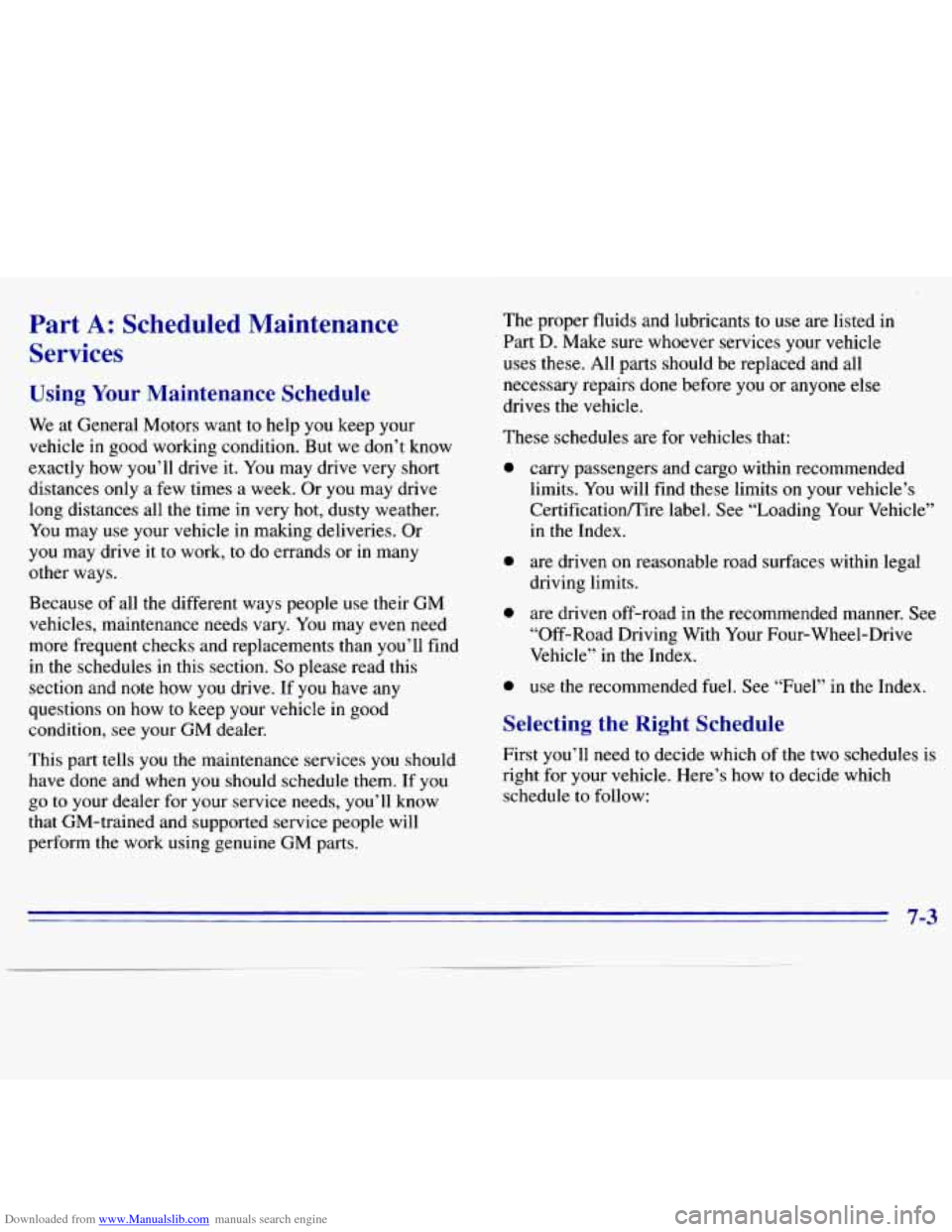
Downloaded from www.Manualslib.com manuals search engine Part A: Scheduled Maintenance
Services
Using Your Maintenance Schedule
We at General Motors want to help you keep your
vehicle in good working condition. But we don’t know
exactly how you’ll drive it. You may drive very short
distances only a
few times a week. Or you may drive
long distances all the time
in very hot, dusty weather.
You may use your vehicle
in making deliveries. Or
you may drive
it to work, to do errands or in many
other ways.
Because of all the different ways people use their GM
vehicles, maintenance needs vary. You may even need
more frequent checks and replacements than you’ll find
in the schedules in this section.
So please read this
section and note
how you drive. If you have any
questions
on how to keep your vehicle in good
condition, see your GM dealer.
This part tells you the maintenance services you should
have done and when you should schedule them. If you
go to your dealer for your service needs, you’ll know
that GM-trained and supported service people will
perform the work using genuine GM parts. The
proper fluids and lubricants to use
are listed in
Part
D. Make sure whoever services your vehicle
uses these. All parts should be replaced and all
necessary repairs done before you or anyone else
drives the vehicle.
These schedules are for vehicles that:
0
carry passengers and cargo within recommended
limits. You will find these limits on your vehicle’s
Certification/Tire label. See “Loading Your Vehicle”
in the Index.
are driven on reasonable road surfaces within legal
driving limits.
are driven off-road in
the recommended manner. See
“Off-Road Driving With Your Four-Wheel-Drive
Vehicle’’ in the Index.
use the recommended fuel. See “Fuel” in the Index.
Selecting the Right Schedule
First you’ll need to decide which of the two schedules is
right for your vehicle. Here’s how to decide which
schedule to follow:
7-3